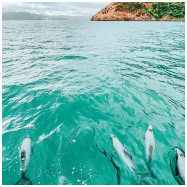Research shows Hector’s dolphin sightings have moved further down Akaroa Harbour
 This week, the Department of Conservation have released research into the distribution of the Hector’s dolphins within Akaroa Harbour. The research concluded that over the past 20 years, the local Hector’s dolphin population is sighted less frequently in the inner harbour region, and more frequently towards the harbour entrance.
This week, the Department of Conservation have released research into the distribution of the Hector’s dolphins within Akaroa Harbour. The research concluded that over the past 20 years, the local Hector’s dolphin population is sighted less frequently in the inner harbour region, and more frequently towards the harbour entrance.
Black Cat Cruises Chief Executive, Paul Milligan, said “our team on the water feel the research findings align with what we have witnessed over the last 20 years; we still see dolphins on 98% of our cruises which is an extremely high success rate, they are just located slightly further down the harbour than previously”.
Black Cat Cruises are one of the local operators who have contributed towards the study.
They have a long standing relationship with the Department of Conservation and with the researchers based at the University of Otago.
Milligan says “the Hector’s dolphins are an incredibly treasured species and one that must be better understood and protected. We have lobbied for many years for further protection from the known causes of mortality for the Hector’s Dolphins which are listed as Nationally Vulnerable by the Department of Conservation”.
The Ministry of Fisheries recently released an update to the Hector’s Dolphin Threat Management Plan which extended the area where set nets were allowed around the peninsula. “This is another positive step forward in the protection of the Hector’s Dolphins. Set nets are known to catch and kill Hector’s Dolphins and managing this form of fishing is key to protecting the species” Milligan said.
The research carried out by Will Carome from the University of Otago noted a shift in dolphin distribution over a time period where cruise ship visits to Akaroa had increased. This research also noted that there are many other factors that may have contributed towards the shift in dolphin habitat including changes in the sea temperature, food sources, or prey.
Despite the reduction in tourism activity due to Covid and structural changes related to the 2011 earthquake, dolphin tourism remains the backbone of the Akaroa community. An independent Economic Impact study funded by Black Cat Cruises in 2019 found that Hector’s Dolphins contributed $24.5M annually to the local Economy.
With the opening of the new Cruise Ship terminal in Lyttelton, Akaroa will see a significant drop in Cruise Ship visits this coming summer, with a similar number of port calls as pre 2011. Black Cat Cruises believes this gives everyone the opportunity to assess any further changes to the dolphin distribution while also assessing other contributing factors such as sea temperatures.
The key message from the research is that the distribution of the dolphins has changed over time and we need to better understand all possible impacts.
ADDITIONAL NOTES:
Black Cat Cruises is a Banks Peninsula based tourism business operating out of both Lyttelton and Akaroa Harbour. The company was founded in 1985 in Akaroa and is recognised as one of New Zealand’s first eco-tourism operators. Highlights for the Qualmark Gold company include being awarded the New Zealand Tourism Award for Conservation in 2019, Business Excellence in 2016, and previous Supreme Tourism Award winner.
2019 Economic Impact Report can be downloaded here.

